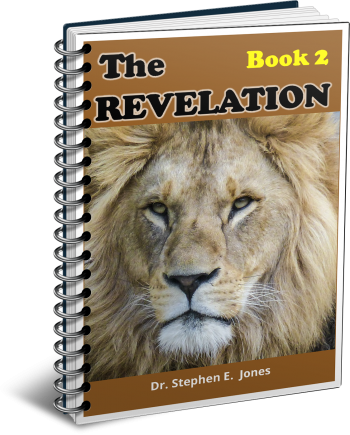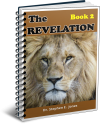Latest Posts
View the latest posts in an easy-to-read list format, with filtering options.

A study of Revelation 2-5, from Rev. 2:18 to the end of Rev. 5. This is book 2 of an 8 part book series.
Category - Bible Commentaries

Revelation 4:4 says,
4 And around the throne were twenty-four thrones; and upon the thrones I saw twenty-four elders sitting, clothed in white garments, and golden crowns on their heads.
In this scene there are 25 thrones—one for Jesus and one for each of the 24 elders. In Dan. 7:9, which describes the throne and the heavenly court, we are told, “I kept looking until thrones were set up, and the Ancient of Days took His seat.” Daniel does not specify how many thrones were set up, but it is clear that there was more than one throne.
The ultimate fulfillment of Daniel’s prophecy is seen in Rev. 20:11, which describes “a great white throne and Him who sat upon it.” Earlier, in Rev. 20:4, we read, “And I saw thrones, and they sat upon them, and judgment was given to them.” Who are these? John says they are the ones eligible for the first resurrection on account of their testimony (i.e., the Amen people, the overcomers).
Dan. 7:21, 22 says of them,
21 I kept looking, and that horn was waging war with the saints and overpowering them 22 until the Ancient of Days came, and judgment was passed in favor of the saints of the Highest One, and the time arrived when the saints took possession of the kingdom.
Hence, Daniel calls them “saints of the Highest One” (i.e., the Most High God, or El Elyon), while John describes them as being true worshipers of God, not receiving the beast’s image or mark. Both writers agree that these are the ones given authority in the kingdom when the final beast’s dominion comes to an end.
The 24 elders appear to be leaders among the overcoming “saints.” Jesus Himself spoke of twelve thrones, one for each of His disciples, in Matt. 19:28,
28 And Jesus said to them, “Truly I say to you, that you who have followed Me, in the regeneration when the Son of Man will sit on His glorious throne, you also shall sit upon twelve thrones, judging the twelve tribes of Israel.”
This is an obvious reference to the Ancient of Days (Christ) sitting on the throne, surrounded by other thrones that form the Divine Council. But Jesus did not limit the Council to just twelve. He said only that the twelve apostles would be part of this Council. John tells us that there are actually “twenty-four elders” (Rev. 4:4) who sit on thrones. This implies twelve additional saints from the Old Testament period, which, when added to the twelve apostles add up to twenty-four.
To obtain a broader picture, we need to compare these numbers (12 apostles and 24 elders) with the twelve “princes” of the tribes and the “seventy” elders set up by Moses to judge the people. Each tribe had a “prince,” who was the head of the tribe. Each prince had five more elders under him, six from each tribe, for a total of 72. These are called “seventy” as a rounded off number, but it was understood to be 72.
This judicial system was organized at the suggestion of Jethro, who was Moses’ father-in-law. His advice to Moses in Exodus 18:19-22 says,
19 Now listen to me: I shall give you counsel, and God be with you. You be the people’s representative before God, and you bring the disputes to God, 20 then teach them the statutes and the laws, and make known to them the way in which they are to walk, and the work they are to do. 21 Furthermore, you shall select out of all the people able men who fear God, men of truth, those who hate dishonest gain; and you shall place these over them, as leaders of thousands, of hundreds, of fifties and of tens. 22 And let them judge the people at all times; and let it be that every major dispute they will bring to you, but every minor dispute they themselves will judge. So it will be easier for you, and they will bear the burden with you.
Hence, the numbers 12 and 72 were important in Israel’s judicial system. In the time of David, the twelve were expanded to 24, implying also that the 72 was expanded to 144. In the book of Revelation these numbers are multiplied further to 144,000 and to 288,000. We will explain this further at a later time.
When Israel sinned by worshiping the golden calf, it became apparent that the Israelites needed a second court outside the camp, so that those who were defiled could come for cleansing before being allowed to re-enter the camp of Israel. Hence, in the wake of the golden calf incident, Exodus 33:7 says,
7 Now Moses used to take the tent and pitch it outside the camp, a good distance from the camp, and he called it the tent of meeting. And it came about, that everyone who sought the Lord would go out to the tent of meeting which was outside the camp.
Later, this pattern was repeated and enlarged upon when the temple was built in Jerusalem. In the time of Jesus, this court was outside the eastern gate at Bethphage, where a small community of priests resided. These priests oversaw the ashes of the red heifer and the cistern of water, by which men could be purified as they entered the city. It is also the place where Jesus was crucified, as I showed in my book, Luke: Healing the Breaches, Book 8.
So in the days of Moses, there were two courts. The first was the tabernacle itself, where Moses received the word from God. The second was outside the camp, where the common people resolved their disputes and received cleansing from defilement. This was also the place where lepers were inspected to see if they had been healed.
The primary court was the tabernacle (and later, the temple). Exodus 33:8-11 describes what normally occurred when Moses went to the throne of God (Ark) in the tabernacle. He would “stand at the entrance of the tent, and the Lord would speak with Moses” (Exodus 33:9). Was this an audible voice? Was it loud enough for all to hear? Verse 11 says,
11 Thus the Lord used to speak to Moses face to face, just as a man speaks to his friend. When Moses returned to the camp, his servant, Joshua, the son of Nun, a young man, would not depart from the tent.
So we see that Joshua was present with Moses at the tent when God spoke. Moses stood “at the entrance of the tent,” while Joshua was inside the tent. Even when Moses left the scene, Joshua remained in the tent. Joshua 1:1 says that Joshua was “Moses’ minister” (KJV), or “Moses’ servant” (NASB). What was he doing at the tent? Since Joshua was a type of Yeshua (Jesus), it is likely that he was the one through whom the word was given to Moses and to the people. Heb. 1:1, 2 says,
1 God, after He spoke long ago to the fathers in the prophets in many portions and in many ways, 2 in these last days has spoken to us in His Son, whom He appointed heir of all things, through whom also He made the world.
If Jesus was to speak to us “in these last days,” then this suggests that Joshua was an earlier type of Christ filling that role in his time. It appears, then, that the Father spoke to Joshua, and Joshua (“the Amen”) repeated it word for word, so that Moses would hear it audibly.
This court system has now been expanded greatly since the days of Moses. Yet the foundational principles remain unchanged. Yeshua-Jesus still speaks to us in these last days, repeating what He has heard from the Father (John 14:10). Those who hear His voice may prophesy, even as Moses was a prophet (Deut. 18:18), that is, a spokesman who was called to repeat the testimony of Jesus faithfully.
The primary court at the tabernacle was for “every major dispute” (Exodus 18:22, NASB). In essence, it formed a Supreme Court. The secondary court, which Moses established outside the camp, was for “every minor dispute.”
These two courts are reflected in later prophecies about the Great White Throne and the other thrones. Even as Jethro told Moses in Exodus 18:20 to appoint elders and “teach them the statutes and the laws,” so that they could judge most disputes among the people, so also has Christ appointed apostles and elders to learn the laws of God and judge the people righteously.
In Rev. 4:4 John saw the 24 elders wearing white garments and having golden crowns on their heads. The white garments indicate “the righteous acts of the saints” (Rev. 19:8). White garments (fine linens) are also the dress of priests. Hence, these 24 elders are called to be “priests of God and of Christ” (Rev. 20:6). In Moses’ time, only priests were allowed within the tabernacle itself. The 24 elders surrounding the throne were called as priests. Since the twelve apostles formed half of these judges, it follows that the apostles—regardless of their tribal affiliations—were priests in the Order of Melchizedek.
They also are said to wear “crowns.” The Greek word is stephanos, “wreath, or garland” given to a victor at public games. This word is not the same as a diadem as pictured in Rev. 19:12, where we read of Christ, “and upon His head are many diadems.”
The Apostle Paul, knowing that he was soon to be executed in Rome, said in 2 Tim. 4:7, 8,
7 I have fought the good fight, I have finished the course, I have kept the faith; 8 in the future there is laid up for me the crown [stephanos] of righteousness, which the Lord, the righteous Judge, will award to me on that day; and not only to me, but also to all who have loved His appearing.
Further, the importance of obeying “the rules” is emphasized by Paul in 2 Tim. 2:5,
5 And also if anyone competes as an athlete, he does not win the prize unless he competes according to the rules [nomimos, “lawfully”].
There are many who run the race and try to win the prize in an unlawful manner. But the stephanos is not given to those who “cheat” in a race. Such people do not like the rules, thinking that rules are too restrictive. They desire “freedom in Christ,” not realizing that their lawlessness disqualifies them from the prize. In the end, Jesus will say to them, “depart from Me, you who practice lawlessness” (Matt. 7:23).